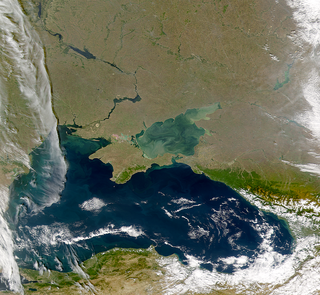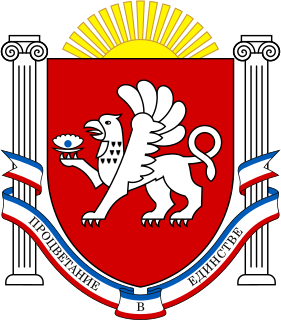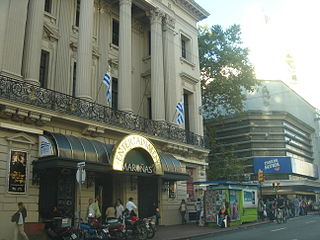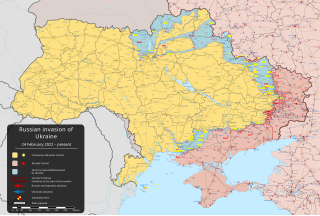Related Research Articles
The Tatars is an umbrella term for different Turkic ethnic groups bearing the name "Tatar". Initially, the ethnonym Tatar possibly referred to the Tatar confederation. That confederation was eventually incorporated into the Mongol Empire when Genghis Khan unified the various steppe tribes. Historically, the term Tatars was applied to anyone originating from the vast Northern and Central Asian landmass then known as Tartary, a term which was also conflated with the Mongol Empire itself. More recently, however, the term has come to refer more narrowly to related ethnic groups who refer to themselves as Tatars or who speak languages that are commonly referred to as Tatar, namely Tatar by Volga Tatars, Crimean Tatar by Crimean Tatars and Siberian Tatar by Siberian Tatars.

Crimea is a peninsula in Eastern Europe. It is situated along the northern coast of the Black Sea, and has a population of 2.4 million, made up mostly of ethnic Russians with significant Ukrainian and Crimean Tatar minorities, among others. The peninsula is almost entirely surrounded by both the Black Sea and the smaller Sea of Azov; it is located south of Kherson Oblast in Ukraine, to which it is connected by the Isthmus of Perekop, and west of Krasnodar Krai in Russia, from which it is separated by the Strait of Kerch though linked by the Crimean Bridge since 2018. The Arabat Spit is located to its northeast, a narrow strip of land that separates a system of lagoons named Sivash from the Sea of Azov. Across the Black Sea to the west lies Romania and to the south is Turkey.

The federal districts are groupings of the federal subjects of Russia. Federal districts are not mentioned in the nation's constitution, and do not have competences of their own and do not manage regional affairs. They exist solely to monitor consistency between the federal and regional bodies of law, and ensuring governmental control over the civil service, judiciary, and federal agencies, operating in the regions.

Crimean Tatars or Crimeans, are a Turkic ethnic group and nation who are an indigenous people of Crimea. The formation and ethnogenesis of Crimean Tatars occurred during the 13th–17th centuries, uniting Cumans that appeared in Crimea in the 10th century with other peoples who ever inhabited Crimea since ancient times and gradually underwent Tatarization, including the Greeks, Italians and Goths.

The Crimean Khanate, officially the Great Horde and Desht-i Kipchak and in old European historiography and geography known as Little Tartary, was a Crimean Tatar state existing from 1441 to 1783, the longest-lived of the Turkic khanates that succeeded the empire of the Golden Horde. Established by Hacı I Giray in 1441, it was regarded as the direct heir to the Golden Horde and to Desht-i-Kipchak.

The transfer of the Crimean Oblast in 1954 was an administrative action of the Presidium of the Supreme Soviet of the Soviet Union, which transferred the government of the Crimean Peninsula from the Russian Soviet Federative Socialist Republic to the Ukrainian SSR.
Enrique E. Tarigo Vázquez was a Uruguayan jurist and political figure.

The Battle of the Tarigo Convoy was a naval battle of World War II, part of the Battle of the Mediterranean. It was fought on 16 April 1941, between four British and three Italian destroyers, near the Kerkennah Islands off Sfax, in the Tunisian coast. The battle was named after the Italian flagship, the destroyer Luca Tarigo.

The recorded history of the Crimean Peninsula, historically known as Tauris, Taurica, and the Tauric Chersonese, begins around the 5th century BC when several Greek colonies were established along its coast. The southern coast remained Greek in culture for almost two thousand years as part of the Roman Empire, and its successor states, the Byzantine Empire, the Empire of Trebizond, and the independent Principality of Theodoro. In the 13th century, some Crimean port cities were controlled by the Venetians and by the Genovese, but the interior was much less stable, enduring a long series of conquests and invasions. By the early medieval period it had been settled by Scythians (Scytho-Cimmerians), Tauri, Greeks, Romans, Goths, Huns, Bulgars, Kipchaks and Khazars. In the medieval period, it was acquired partly by Kievan Rus', but fell to the Mongol invasions, specifically to the Golden Horde. These were followed in the 15th to 18th centuries by the Crimean Khanate and the Ottoman Empire, which conquered the coastal areas as well.

Verkhovna Rada of Crimea or the Supreme Council of Crimea, officially the Supreme Council of the Autonomous Republic of Crimea was a Ukrainian legislative body of the Autonomous Republic of Crimea before the annexation of Crimea by the Russian Federation in 2014.

El Día was an influential Uruguayan daily newspaper.

The Crimean status referendum of 2014 was a disputed referendum concerning the status of Crimea, held on March 16, 2014 in the Autonomous Republic of Crimea and the local government of Sevastopol. The referendum was approved and held amidst Russia's annexation of Crimea. The referendum asked local populations whether they wanted to rejoin Russia as a federal subject, or if they wanted to restore the 1992 Crimean constitution and Crimea's status as a part of Ukraine. The official result from the Autonomous Republic of Crimea was a 97 percent vote for integration of the region into the Russian Federation with an 83 percent voter turnout, and within the local government of Sevastopol there was also a 97 percent vote for integration of the region into the Russian Federation with an 89 percent voter turnout.

The Russo-Ukrainian War is an ongoing war between Russia and Ukraine. It began in February 2014 following the Ukrainian Revolution of Dignity, and initially focused on the status of Crimea and parts of the Donbas, internationally recognised as part of Ukraine. The first eight years of the conflict included the Russian annexation of Crimea (2014) and the war in Donbas (2014–present) between Ukraine and Russian-backed separatists, as well as naval incidents, cyberwarfare, and political tensions. Following a Russian military build-up on the Russia–Ukraine border from late 2021, the conflict expanded significantly when Russia launched a full-scale invasion of Ukraine on 24 February 2022.

The Autonomous Republic of Crimea is a de jure autonomous republic of Ukraine encompassing most of Crimea that was annexed by Russia in 2014.

In February and March 2014, Russia invaded and subsequently annexed the Crimean Peninsula from Ukraine. This event took place in the aftermath of the Revolution of Dignity and is part of the wider Russo-Ukrainian War.

The Republic of Crimea is a de facto federal subject (republic) of Russia. Its territory corresponds to the Autonomous Republic of Crimea, a de jure subdivision of Ukraine.

United Nations General Assembly Resolution 68/262 was adopted on 27 March 2014 by the sixty-eighth session of the United Nations General Assembly in response to the Russian annexation of Crimea and entitled "territorial integrity of Ukraine". The nonbinding resolution, which was supported by 100 United Nations member states, affirmed the General Assembly's commitment to the territorial integrity of Ukraine within its internationally recognized borders and underscored the invalidity of the 2014 Crimean referendum. Eleven nations voted against the resolution, while 58 abstained, and a further 24 states were absent when the vote took place.
The Crimean problem or the Crimean question is a dispute over the status of Crimea between Ukraine and Russia. The dispute began during the dissolution of the Soviet Union, but did not escalate into a conflict until the 2014 Ukrainian revolution, when Russian special forces were deployed to occupy Crimea and took over its government buildings. The official results of a disputed referendum held during the Russian occupation indicated overwhelming support for annexation to Russia, and the Supreme Council of Crimea unilaterally declared their independence from Ukraine as a state under the name of Republic of Crimea. The republic was then annexed by Russia, whereby the former Autonomous Republic of Crimea became the "Republic of Crimea" as a Russian republic and former city with special status of Sevastopol became a Russian federal city. Ukraine and the majority of the international community continue to regard Crimea as occupied Ukrainian territory. Despite international opinion however, the currency, tax, time zone and legal system are all operational under de facto Russian control. Ukraine has attempted to resolve the matter by filing litigation in multiple international criminal, environmental, political, and other courts.
Luca Tarigo was one of a dozen Navigatori-class destroyers built for the Regia Marina in the late 1920s. Completed in 1929, she served in World War II.
References
- Nikolai Murzakevič: Storia delle colonie genovesi in Crimea. Genua 1992. ISBN 88-7058-467-4